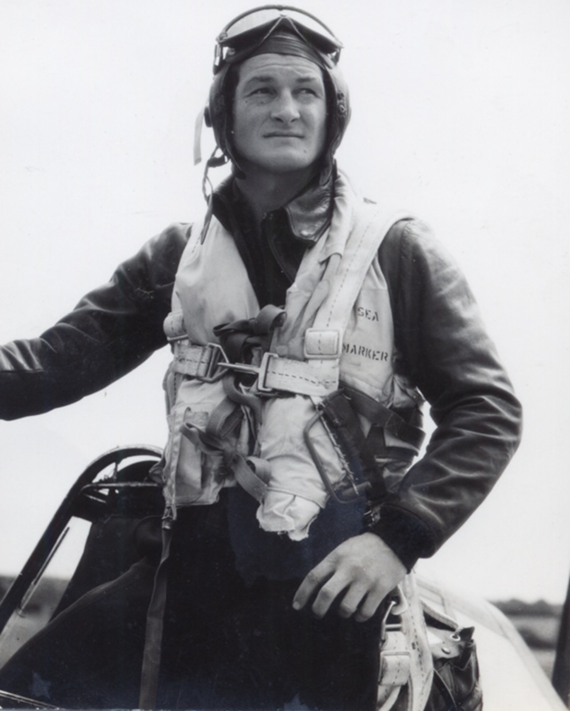“Lieutenant McMahan immediately began circling the wounded ship, calling encouragement and setting their course for the shortest flight home. All went well until they neared the coast, when a wall of flak suddenly loomed up before them. As Lieutenant Pierce described it, the flak started to come up and there wasn’t a thing they could do. ‘We were at 2,000 feet of perfect altitude for the guns and I could neither maneuver nor run for it.’”
“Lieutenant McMahan was up ahead and when he saw what was happening, he threw all caution to the winds and turned and did a virtual suicide dive straight into the flak guns. A fighter coming in like that is always a setup for aircraft, but on those rare times he gets in, he usually gets the flak guns. McMahan dove straight into the guns three times. On the third pass they hit him, but he kept on going. By that time, Pierce said, ‘I was a little passed, and putting my damaged ship into a dive, I picked up enough speed to get away from them, but Mac shooting up those guns was the nerviest thing I ever saw. I don’t know how the kid ever came through.’”
McMahan’s efforts that day earned him the Distinguished Service Cross, the second highest award that can be given to a member of the United States Army. The citation synopsis reads as follows:
“First Lieutenant (Air Corps) Darrel E. McMahan (ASN: 0-763699), United States Army Air Forces, was awarded the Distinguished Service Cross for extraordinary heroism in connection with military operations against an armed enemy while serving as Pilot of a P-47 Fighter Airplane in the 62d Fighter Squadron, 56th Fighter Group, EIGHTH Air Force, in aerial combat against enemy forces on 2 September 1944. On that date, First Lieutenant McMahan shot down one enemy airplane. First Lieutenant McMahan’s unquestionable valor in aerial combat is in keeping with the highest traditions of the military service and reflects great credit upon himself, the 8th Air Force, and the United States Army Air Forces.”
McMahan’s service didn’t end there.
On Sept. 17, 1944, just days after his heroic efforts over Belgium, McMahan was flying a mission over Holland when he came under heavy fire. McMahan was able to make a safe landing in his nearly unrecognizable P-47, but not without the efforts of a fellow pilot from Berkeley, Calif., who guided him home by radio – a pilot who, McMahan said, saved his life.
]That mission was McMahan’s last. His right arm was broken in two places, his right kneecap was splintered, and he had multiple fractures in his right leg. After 60 missions and 195 hours in the air, McMahan was sent back to the United States to recover at the Santa Ana Army Air Base Hospital.
When he was able to leave the hospital, still suited in a cast on one side from hip to toe, and from shoulder to fingertip, McMahan joined some friends on a trip to the snow in Idyllwild, Calif. There, they were welcomed into the home of a young woman who had lost her brother in the war. Bud, a Marine who was killed in Guam, left behind a young widow named Alice McGinnis. Bud’s sister invited Alice to her house, encouraging her to come meet an especially nice young airman who had recently returned from the war. Darrel and Alice McMahan were married three months later.“Mac was kind of lost for a while there after the war,” Alice said. “He was working, but he’d find ways to watch football games when he could.”
McMahan told Alice that he credited a lot of his success in the war to his high school football coach. So, in turn, McMahan decided to become a coach himself.
He enrolled in courses at San Jose State University, majoring in history. His first job out of college was in Visalia, where he taught high school biology and served as the basketball coach. He was eventually led to Santa Paula High School where he served as a teacher, football coach, dean of students, and principal until he retired in 1981. For his commitment to the students of Santa Paula, the boy’s gym was named in his honor – a standing tribute to a life well lived.
McMahan was able to pull flak from his arm for years after the war – a constant reminder of the missions he flew over Europe. But still, he’d never talk about. He might have joked here or there, Alice said, but he never gave details. His students knew the slight limp was from a war wound, but they didn’t know where or how it happened. At just 20, McMahan had been witness to the horrifying reality of war – it was more than some of his students, or even his family, could have ever imagined.
In his October 1944 broadcast, Malone wrote two sentences that preceded the story about McMahan’s heroic efforts – two sentences that perhaps best describe what was asked of the countless teenagers and young men sent to combat:
“There are thousands of stories every day, but no two are alike because they are about different boys. And yet nearly all have one thing in common – boys behaving like men.”
Jannette Jauregui is a native of Santa Paula, and is the author of three books, including Of War and Life: A Decade of Stories, and Ventura County Veterans: World War II to Vietnam. Jannette welcomes story ideas for Hometown Heroes from throughout Ventura County. Those interested in submitting a story idea may contact Jannette via e-mail at hometownheroes805@gmail.com.



